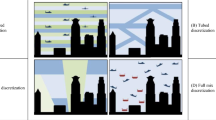Abstract
A large number of unmanned aerial vehicle (UAV) trajectory data related to air traffic information has important value in engineering fields. However, the cost of data and trajectory processing limits the applications, and as the number of UAVs increases rapidly, future UAVs’ path data will be very large. Therefore, this paper designs a multi-UAV route re-generation method based on trajectory data, which can realize the UAVs’ path data compression, de-aggregation, and regeneration tasks. Based on the trajectory data, the three-dimensional Douglas-Peucker algorithm is used to compress the trajectory data to reduce the storage space. The improved B-spline path smoothing algorithm based on the reversing control point is used to depolymerize and smooth the path. Simulation experiments show that the above multi-UAV route re-generation algorithm can obtain a more optimized path while maintaining the important characteristics of the original path.
Similar content being viewed by others
References
KHATIB O. Real-time obstacle avoidance for manipulators and mobile robots [J]. The International Journal of Robotics Research, 1986, 5(1): 396–404.
SUDHAKARA P, GANAPATHY V, PRIYADHARSHINI B, et al. Obstacle avoidance and navigation planning of a wheeled mobile robot using amended artificial potential field method [J]. Procedia Computer Science, 2018, 133: 998–1004.
CHEN H, LI Y, LUO J D. Research of mobile robot path planning based on improved A* algorithm optimization [J]. Automation & Instrumentation, 2018 (12): 1–4 (in Chinese).
LU W L, LEI J S, SHAO Y. Path planning for mobile robot based on an improved A* algorithm [J]. Journal of Ordnance Equipment Engineering, 2019, 40(4): 197–201 (in Chinese).
JIA G Z. Research on three-dimensional flight path planning of UAV based on genetic algorithm and sparse A* algorithm [D]. Nanjing, China: Nanjing University of Posts and Telecommunications, 2017 (in Chinese).
NOBAHARI H, POURTAKDOUST S H. An optimal-fuzzy two-phase CLOS guidance law design using ant colony optimisation [J]. The Aeronautical Journal, 2007, 111(1124): 621–636.
BAGHERIAN M, ALOS A. 3D UAV trajectory planning using evolutionary algorithms: A comparison study [J]. The Aeronautical Journal, 2015, 119(1220): 1271–1285.
BAI Y Z. Three-dimensional path planning based on parameter variance adjustment firefly algorithm [J]. Computer System & Applications, 2015, 24(5): 92–99 (in Chinese).
CHEN Y, WU K Q, WANG D, et al. Elastic algorithm: A new path planning algorithm about auto-navigation in 3D virtual scene [M]//Advances in artificial reality and tele-existence. Berlin, Heidelberg: Springer, 2006: 1156–1165.
BRANDT T, SATTEL T. Path planning for automotive collision avoidance based on elastic bands [J]. IFAC Proceedings Volumes, 2005, 38(1): 210–215.
XING Y X. Research on search and rescue optimization of UAV disaster area based on swarm intelligence algorithm [D]. Dalian, China: Dalian University of Technology, 2019 (in Chinese).
LI L L. Path planning algorithm for robots based on elastic band theory [D]. Xi’an, China: Xidian University, 2013 (in Chinese).
HILGERT J, HIRSCH K, BERTRAM T, et al. Emergency path planning for autonomous vehicles using elastic band theory [C]// Proceedings 2003 IEEE/ASME International Conference on Advanced Intelligent Mechatronics. Kobe, Japan: IEEE, 2003: 1390–1395.
ZHANG S K. Data-driven based automatic routing for unmanned ship and surface vehick [D]. Dalian, China: Dalian Maritime University, 2016 (in Chinese).
ZHAO L B, SHI G Y. A method for simplifying ship trajectory based on improved Douglas-Peucker algorithm [J]. Ocean Engineering, 2018, 166: 37–46.
ZHAO L B, SHI G Y. A trajectory clustering method based on Douglas-Peucker compression and density for marine traffic pattern recognition [J]. Ocean Engineering, 2019, 172: 456–467.
DOU S Q. A synchronous simplified method of the river network line vector and DEM based on the three dimensional DP algorithm [D]. Beijing, China: China University of Mining and Technology, Beijing, 2015 (in Chinese).
DOU S Q, LIU C J, LIN Y W, et al. A method of multi-beam echo sounding system data thinning based on improved 3D Douglas-Peucker algorithm [J]. Science & Technology Review, 2014, 32(19): 21–25 (in Chinese).
SUN R, ZHANG W S. Smooth path planning of mobile robot based on improved ant colony algorithm [J]. Journal of Graphics, 2019, 40(2): 344–350 (in Chinese).
WANG B R, WANG T, LI Z G, et al. An adaptive look-ahead positioin and orientation interpolation algorithm for multi-path segments smooth transition [J]. Control and Decision, 2019, 34(6): 1211–1218 (in Chinese).
ELBANHAWI M, SIMIC M, JAZAR R N. Continuous path smoothing for car-like robots using B-spline curves [J]. Journal of Intelligent & Robotic Systems, 2015, 80(1): 23–56.
SINGH A K, AGGARWAL V, SAXENA P, et al. Performance analysis of trajectory compression algorithms on marine surveillance data [C]//International Conference on Advances in Computing, Communications and Informatics. Udupi, India: IEEE, 2017: 1074–1079.
Acknowledgement
We are grateful to Dr. Wang Jianan who made some important analysis for the article, and also greatly appreciate Mr. Tian Jingfan’s useful discussion.
Author information
Authors and Affiliations
Corresponding author
Rights and permissions
About this article
Cite this article
Yuan, D., Wang, Y. & Bai, J. Multi-UAV Route Re-Generation Method Based on Trajectory Data. J. Shanghai Jiaotong Univ. (Sci.) 27, 806–816 (2022). https://doi.org/10.1007/s12204-021-2332-2
Received:
Accepted:
Published:
Issue Date:
DOI: https://doi.org/10.1007/s12204-021-2332-2
Key words
- unmanned aerial vehicle (UAV)
- trajectory data
- route re-generation
- three-dimensional Douglas-Peucker algorithm
- improved B-spline path smoothing algorithm
- reversing control point




